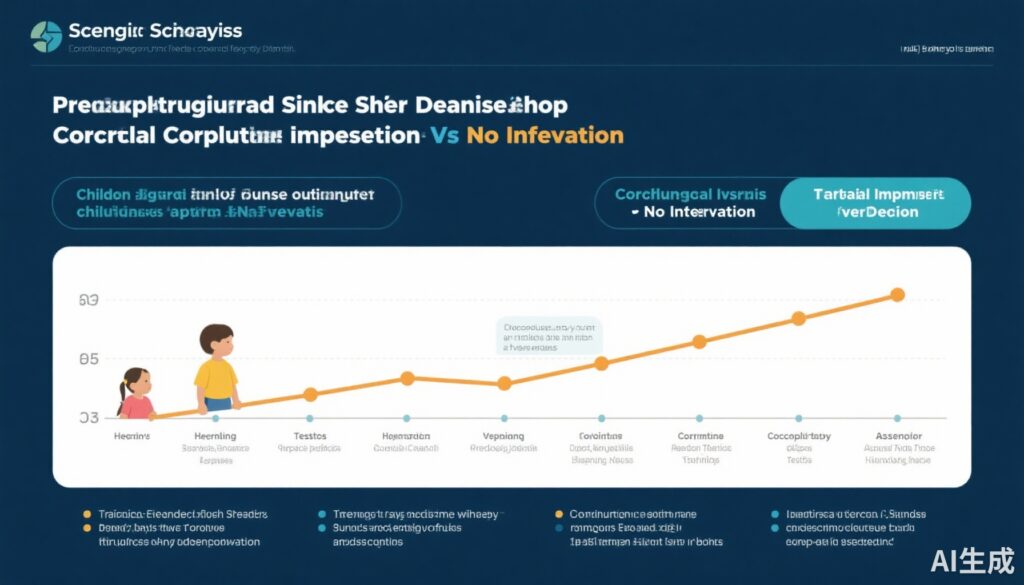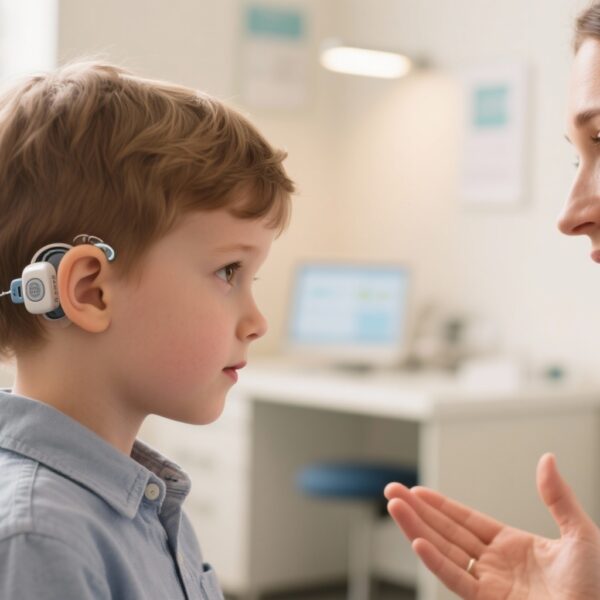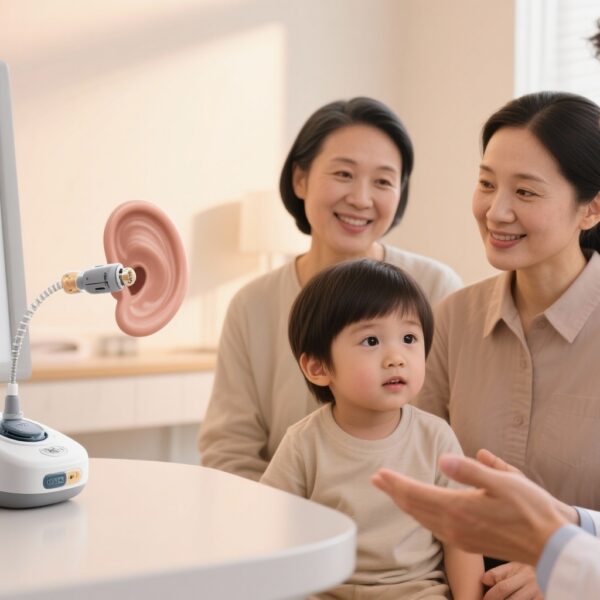Highlights
- Children with prelingual single-sided deafness (SSD) face deficits in speech perception in noise, sound localization, and verbal cognition if untreated.
- Early cochlear implantation (CI) before 2.5 years significantly improves spatial hearing abilities and verbal intelligence quotient (IQ), normalizing performance relative to bilateral normal-hearing peers.
- CIs in SSD facilitate typical longitudinal developmental trajectories across auditory, cognitive, and balance domains without adverse effects on postural control.
- Guidelines for clinical follow-up and individualized rehabilitation protocols are essential to optimize long-term outcomes in children with SSD receiving early CI.
Background
Single-sided deafness (SSD) in children, defined as severe-to-profound hearing loss in one ear with normal hearing in the contralateral ear, disrupts access to binaural hearing cues crucial for speech recognition in noise and precise sound localization. These auditory deficits are compounded by elevated risks of delays in language acquisition, cognitive processing, and academic achievement. Untreated SSD may lead to cortical reorganization manifesting as an aural preference syndrome, where the auditory cortex preferentially processes input from the better-hearing ear, thereby limiting neuroplastic recovery.
Cochlear implantation (CI) in the deaf ear offers a prospective intervention to restore bilateral auditory input, potentially mitigating neurodevelopmental risks. However, longitudinal evidence regarding the multifaceted developmental benefits of early CI in prelingual SSD and its impact on spatial hearing, cognitive skills, and postural balance remains limited but critically needed to inform clinical decision making.
Key Content
Evidence from Longitudinal Cohort Studies
The seminal prospective longitudinal study by Arras et al. (2025) monitored 37 children with prelingual SSD over a decade, comparing spatial hearing, cognitive, and balance development between those receiving early CI (before 2.5 years; n=20) and non-implanted peers (n=17), as well as 33 bilateral normal hearing (NH) controls. Standardized assessment tools included speech reception thresholds (SRT) in noise across three spatial conditions, sound localization accuracy in a nine-loudspeaker setup, Wechsler Preschool and Primary Scale of Intelligence (WPPSI) for cognitive evaluation, and the Bruininks-Oseretsky Test of Motor Proficiency (BOT-2) to examine postural balance.
Results demonstrated that non-implanted SSD children exhibited significantly poorer speech perception in noise (SRTs elevated by 1.6 to 16.8 dB depending on spatial configurations), larger localization errors averaging 35.4°, and reduced verbal IQ scores by approximately 0.78 standard deviations relative to NH peers. Contrastingly, early CI recipients performed comparably to NH controls cognitively and outperformed nonimplanted SSD peers on speech perception (up to 11.1 dB improvement) and localization tasks (9.5° better accuracy), indicating substantial mitigation of auditory deprivation effects.
Behavioral assessments of balance revealed no significant differences between implanted and nonimplanted SSD children, suggesting that unilateral auditory loss and CI intervention do not differentially affect postural control development.
Consistent Evidence from Complementary Research
Further corroborative studies highlight the sustained auditory benefits of cochlear implantation across pediatric unilateral hearing loss cohorts. For instance, studies assessing cochlear implant sound processor usage (Van Wieringen et al., 2024) and speech recognition improvements over 2 years post-implantation (Sladen et al., 2023) confirm that early bilateral auditory input promotes better speech outcomes and binaural hearing function.
Additionally, research into cognitive development following cochlear implantation (Weber et al., 2023) underscores progressive increases in verbal and nonverbal IQ over time, with verbal skills improving most markedly within the first years after CI activation, emphasizing the neurodevelopmental impact of early auditory restoration.
The detrimental neural effects of untreated SSD, including cortical aural preference alterations, are also supported by imaging studies and underscore the critical window for early intervention.
Mechanistic Insights and Neuroplasticity
SSD leads to asymmetrical auditory input that can induce cortical reorganization and decreased binaural integration efficiency. Early CI facilitates balanced auditory stimulation, supporting normal auditory pathway development and reducing adverse neuroplastic changes. The observed cognitive and auditory improvements likely reflect enhanced cortical and subcortical processing capabilities maintained by bilateral ear stimulation.
Clinical Follow-up and Rehabilitation Recommendations
Given the demonstrated benefits of early CI, clinical practice guidelines advocate for:
- Early diagnosis of SSD with comprehensive audiological and cognitive assessments.
- CI candidacy evaluation and timely implantation preferably before 2.5 years of age to leverage optimal neuroplasticity windows.
- Structured auditory-verbal therapy and language rehabilitation integrated post-implantation, as longer therapies are correlated with superior language and speech outcomes.
- Longitudinal monitoring of spatial hearing skills, cognitive development, and device use adherence to tailor interventions.
- Multidisciplinary approaches addressing auditory, speech-language, cognitive, and motor domains for holistic developmental support.
Expert Commentary
The robust findings from longitudinal cohorts like Arras et al. (2025) provide compelling evidence that early intervention with cochlear implantation in children with prelingual SSD substantially improves auditory spatial abilities and cognitive outcomes, effectively normalizing these developmental trajectories relative to their normal-hearing counterparts. The integration of spatial hearing restoration through CI likely underpins improvements in verbal IQ, reflecting the intertwined nature of auditory input quality and language processing in early childhood.
Notably, the absence of balance differences between CI and non-CI SSD children suggests that vestibular and postural functions are either less vulnerable or compensated independently of auditory input, important for counseling families regarding functional expectations.
Limitations include variability in device use adherence over time, as seen in some cohorts, and the need for extended follow-up beyond early childhood into adolescence to understand long-term neurodevelopmental trajectories fully. Additionally, individual differences highlight the necessity for personalized rehabilitation plans.
These data align with current clinical guidelines and underscore the importance of early identification and bilateral auditory input restoration to prevent neural reorganization and developmental delays.
Conclusion
Emerging evidence decisively supports early cochlear implantation in children with prelingual single-sided deafness to improve speech perception in noise, sound localization, and cognitive development, thereby mitigating the risks associated with auditory deprivation and cortical reorganization. Longitudinal outcomes confirm that implanted children achieve developmental parity with normal-hearing peers, highlighting the clinical imperative for early diagnosis, prompt intervention, and coordinated rehabilitation.
Future research should focus on optimizing rehabilitation strategies, understanding long-term functional outcomes through adolescence, and exploring novel technologies such as gene therapy as adjunct or alternative approaches.
References
- Arras T, Boudewyns A, Dhooge I, Zarowski A, Philips B, Desloovere C, Wouters J, van Wieringen A. Longitudinal Developmental Outcomes of Children With Prelingual Single-Sided Deafness With and Without a Cochlear Implant and Recommendations for Follow-Up. Ear Hear. 2025 Oct 23. doi: 10.1097/AUD.0000000000001724. PMID: 41128504.
- Weber A, et al. Longitudinal Development of Verbal and Nonverbal Intelligence After Cochlear Implantation According to Wechsler Tests in German-speaking Children: A Preliminary Study. Ear Hear. 2023 Mar-Apr;44(2):264-275. doi: 10.1097/AUD.0000000000001278. PMID: 36163636.
- Sladen DP, et al. Two-Year Outcomes of Cochlear Implant Use for Children With Unilateral Hearing Loss: Benefits and Comparison to Children With Normal Hearing. Ear Hear. 2023 Sep-Oct;44(5):955-968. doi: 10.1097/AUD.0000000000001353. PMID: 36879386.
- Van Wieringen A, et al. Long-Term Cochlear Implant Sound Processor Usage in Children with Single-Sided Deafness. Otol Neurotol. 2024 Apr;45(4):392-397. doi: 10.1097/MAO.0000000000004156. PMID: 38478407.



